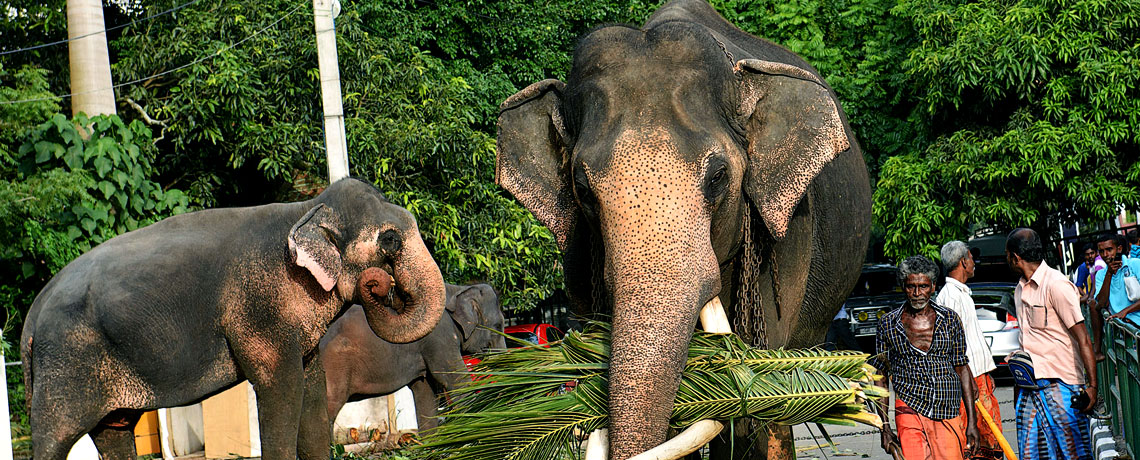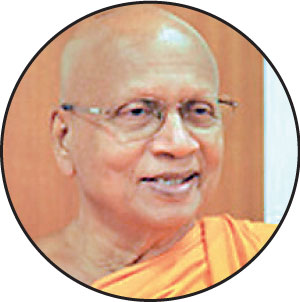14 Feb 2018 - {{hitsCtrl.values.hits}}

 Elephants are becoming the not-so-gentle giants of the jungle! The last time you heard good about an elephant would have probably been in a history lesson and chances are that you will hear more evil about these giants in future. With the tragic killing of the Galgamuwa cross-tusker, a series of elephant deaths made headlines during the latter part of 2017. Another addition to the jumbo-related tragedies was the untimely death of Ven. Dr. Bellanwila Wimalaratana Thera. The monk’s death is a message to those who still engage in keeping elephants in captivity.
Elephants are becoming the not-so-gentle giants of the jungle! The last time you heard good about an elephant would have probably been in a history lesson and chances are that you will hear more evil about these giants in future. With the tragic killing of the Galgamuwa cross-tusker, a series of elephant deaths made headlines during the latter part of 2017. Another addition to the jumbo-related tragedies was the untimely death of Ven. Dr. Bellanwila Wimalaratana Thera. The monk’s death is a message to those who still engage in keeping elephants in captivity.
The story of ‘Myan Kumara’
The issue of captive elephants has been dormant for some time with no solution offered by the authorities concerned. With the introduction of processions during the Kandyan Era, elephants have played a prominent role during ceremonial events. The capture and taming of elephants dates back to the time of the Indus Valley civilisation approximately 4000 years ago when they were captured, trained and made to work. Captive Asian elephants are erroneously referred to as ‘domesticated’ after they are subject to a period of taming. At the onset of the Thera’s death speculation was rife that he was ‘attacked’ by ‘Myan Kumara’ - the temple tusker. However the Daily Mirror learned that at the onset of this incident, the tusker is being ill-treated and shifted from place to place.
Hence the Daily Mirror sheds light on the incident, precautions to take during a chest injury as experienced by the late prelate and the consequences of keeping elephants in captivity.
 “Elephants aren’t ill-treated at the temple” -Ven. Dhammaratana
“Elephants aren’t ill-treated at the temple” -Ven. Dhammaratana
Talking to the Daily Mirror, the present Chief Incumbent of the Bellanwila Rajamaha Viharaya, Ven. Dr. Bellanwila Dhammaratana Nayaka Thera said that he was overseas at the time this incident had taken place. “I only know that Ven. Wimalaratana Thera fell. I didn’t see what happened, so I cannot tell what exactly happened. In fact nobody had seen what had happened. The mahout was on holiday and on the day of this incident the elephant was tied to a coconut tree in the backyard. However the priest had had a severe fall in a way that damaged his ribs. But even at the hospital the Thera had said that he fell and hadn’t mentioned about the tusker attacking him. There are all sorts of stories being written in papers and circulated on social media, but none of these people has seen what happened to the priest,” said Ven. Dr. Bellanwila Dhammaratana Nayaka Thera.
Speaking further the Thera said that if the elephant was angry and actually attacked as said, he would have grabbed the priest once again and trampled him. “But nothing of that sort took place and people were able to move the injured Thera away from the elephant. Myan Kumara doesn’t eat just because there’s food. He needs to be fed. So at such times we have to hold him from the tusk, stand by the side and place the food in his mouth. From my own experiences I remember falling down when an elephant’s trunk knocked against my back when I was in my twenties. The late priest was 76 and he was quite feeble. It is possible that he fell during such an instance. However all medical treatment was given quite successfully, but he unfortunately passed away,” added Ven. Dr. Bellanwila Dhammaratana Nayaka Thera.
When asked about allegations regarding ill-treating the elephant, temple officials confirmed that the elephant is currently at the Daladawatta Temple in Wadduwa but will be brought back to the temple this week. In response to these allegations Ven. thera said that most animal rights activists are quite ignorant and added, “No elephant at Bellanwila Rajamaha Viharaya has been ill-treated. The elephant is now in another location and I went to feed him on Sunday (February 11) as well. We look after them so well; they get enough food and when they fall sick we get local physicians (veda mahaththaya) to treat them. If those activists are so concerned, why can’t they keep these animals with them? Had these elephants been in the wild they would have been shot dead. It’s quite expensive to look after them, but we bear the cost since they are our treasure”.
Doctors observe heavy force behind the fall
Speaking to the the team of doctors that attended to the prelate, during the time of the injury, said that when he was rushed to the Kalubowila Teaching Hospital the prelate had suffered severe blunt trauma to the chest where 10 ribs on the right and six on the left were damaged. “The nature of the injuries showed that the prelate had fallen down with a heavy force. If not such injuries would only persist if one has a bone disease. The priest had mentioned that he fell after feeding the elephant and hadn’t mentioned about an attack,” the doctors said.
The team further said that the staff at the Kalubowila Hospital had administered the appropriate initial treatment, which included inserting a tube into the right chest, administering high flow of oxygen and appropriate pain killers. “A cardiologist at the Kalubowila Teaching hospital first assessed his chest and performed an echocardiograph. He then stated that the priest was fit to be transferred to undergo chest surgery. This surgery lasted seven hours. During the surgery the damaged lung and ribs were repaired using 57 specialised titanium screws and plates. However, according to the attending general physician, the priest was also having diabetes and high blood pressure but these conditions were controlled.” they said.
Although the team put in their fullest efforts to save the priest, he succumbed to a myocardial infarction (heart attack) two hours after the operation. “If he was attacked by the tusker as per speculation, he would have been experiencing severe mental trauma as well. That along with his age, the duration of the surgery and the severity of the injuries could have contributed to the priest’s untimely death,” they added.
 ‘‘Time rife for elephants to live chain-free’’ -Otara Gunewardene
‘‘Time rife for elephants to live chain-free’’ -Otara Gunewardene
Speaking to the Daily Mirror, wildlife enthusiast and Director of Passion Otara Gunewardene said the time is ride to set these innocent animals free. “A large number of people are now aware of the suffering we have caused to these animals over the years and great change is taking place across the world. Even in Sri Lanka there is a much greater understanding with compassionate citizens who know that change is needed and are speaking out for our elephants. It is not to do with going against culture, but to do with awakening of our consciousness to understand another being’s suffering; that all things done in the past are not always right. This is not to do only with animals, but so many things like slavery, women not being able to vote, humans in zoos were also considered alright at one time.
“There are ways that mahouts could be trained,” Gunewardene said elaborating on ways to train elephants without using bull hooks. “I have seen it with my own eyes. I spent a week in Nepal with Carol Buckley where mahouts used Bull hooks and elephants who were all chained now live chain free and no bull hooks are used. She worked with the Government of Nepal and places like Tiger Tops to make them all chain-free. Everyday we would walk with the elephants in the jungle for them to have exercise, to the river for them to have their baths, to cut grass for their food and even walk through villages with about nine elephants in a row with no bull hooks at all. They just used verbal commands and the mahouts’ legs to guide the elephants.
If Nepal can do it why can’t we? I have offered the zoo committee that was set about a year ago to bring Carol down to make the elephants at the zoo chain-free. I have spoken to so many others to change Pinnawala to be a chain-free orphanage for elephants, but they are just not interested. It was finally added to the last budget, but we are yet to see if anything happens about that in the coming months. Temples and other religious places of worship shouldn’t keep elephants in captivity because the time has come where elephants must live chain-free. It is also their duty to show people what is right for these animals and not to convince them into thinking that having them on chains is the right thing.
Even if temples have them they should be in an area where they are free. It is not that we can’t find better solutions for all our elephants; it’s just that we don’t want to nor do we have the leadership, the vision and the heart to create a better life for all lives in our country. This is especially for those like the captive elephants who suffer in silence for our entertainment, profit and ‘merit’,” said Gunewardene.
Dominance-Based versus Positive Reinforcement Training
In the modern times, elephants are considered a prestige symbol. Therefore the elite tend to keep them at their houses in a confined space treating them with everything under the sun. But, freedom is all that they need. According to experts who have studied extensively on elephant behaviour, there’s nothing called a ‘domestic elephant’. Elephants could be trained using two methods:
Experts further reiterate that while the first method is frequently used in Sri Lanka, the second has never even been tried. Dominance-based training involves breaking the animal’s spirit. They obey the master and they are scared of ill-treatment, but this pressure of ill-treatment builds up in the animal and that’s why there are instances of elephants killing mahouts. In Nepal, elephants at the National Trust for Nature Conservation (NTNC) have been trained without the use of chains. They travel through towns and it has been observed that these animals are well-behaved and obey the verbal commands of the mahouts. What is quite interesting to note is that mahouts don’t force the elephants to do what they want. They allow the elephant to take the decision; for example if they encounter a difficult route to get to another side of a river, the mahout doesn’t force the elephant to take that same route. Instead the elephant will find its way to the other bank. However not every elephant in Nepal behaves this way. Therefore it shows that Positive Reinforcement Training is more effective. If the elephant is treated well, the elephant will treat you in return, but the underlined fact is that they are wild.
 ‘‘Mahouts need to be trained’’ - Jayantha Jayewardene
‘‘Mahouts need to be trained’’ - Jayantha Jayewardene
“Elephants have been held in captivity as part of our traditions,” said Asian Elephant Expert and researcher Jayantha Jayewardene. “They were used to plough lands, move stones, build palaces and do other heavy work. But sadly, these elephants are not domesticated. They have been caught from the wild and trained. But they should be allowed to live freely. During the time of Minister Kalugalla, the capture of wild elephants was banned, but this wasn’t implemented. Today the wild elephant population and the tusker population have drastically reduced. What started at 700 has now reduced to less than a 100 tamed elephants.
They are now being used during ceremonies and processions. With the introduction of backhoes and other machinery, the need for elephants to carry out heavy work doesn’t exist. But rich families wanted to own elephants as a symbol of prestige. These elephants cannot be sent back to the wild as well. Since temples cannot afford to look after these giants, they were then given to the daayakayas (main contributors to the temple fund). Hence the temple only wants the elephant during a ceremony,” emphasised Jayewardene.
Stressing on the issue of undertrained mahouts, Jayewardene further said that mahouts have a theory that by hitting an elephant they can control it. “Back in the day elephants and mahouts had a strong relationship. But today, being a mahout is another blue-collar job. Mahouts need to be trained to be kind to elephants,” he concluded.
Precautions to take during a chest injury
According to the doctors, these incidents are quite common in Sri Lanka and each year people die from road traffic accidents alone and a majority of them succumb to chest injuries. Several precautions could be considered if a person experiences such an injury. The first step would always be to call for help.
23 Dec 2024 5 minute ago
23 Dec 2024 14 minute ago
23 Dec 2024 14 minute ago
23 Dec 2024 2 hours ago
23 Dec 2024 3 hours ago